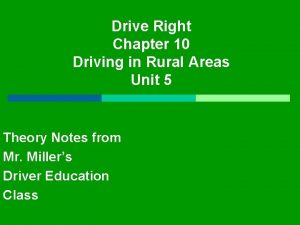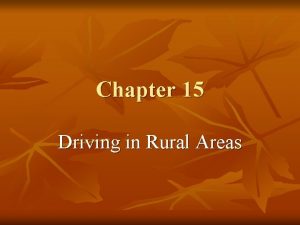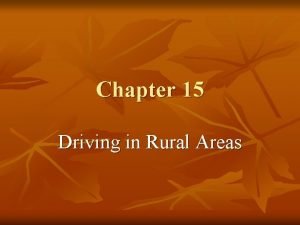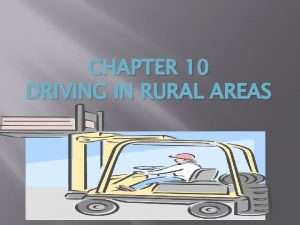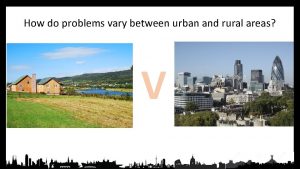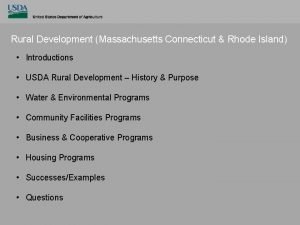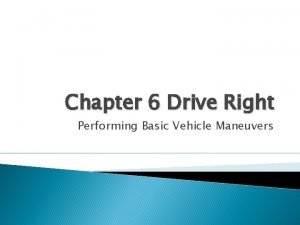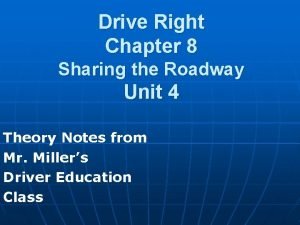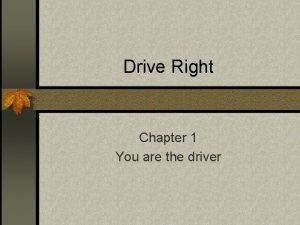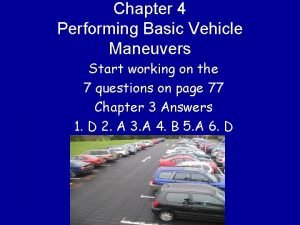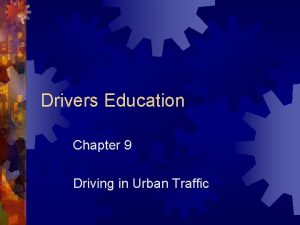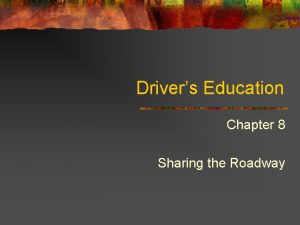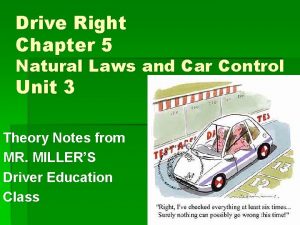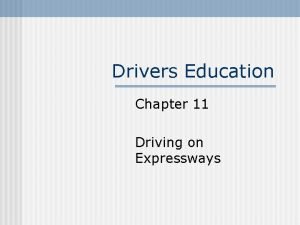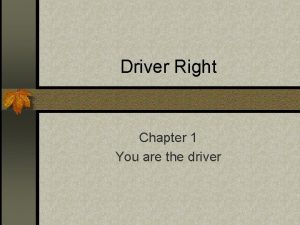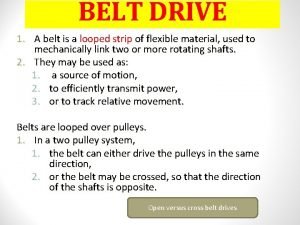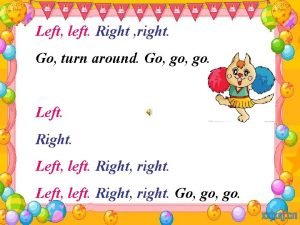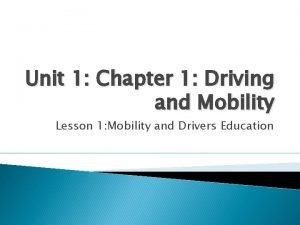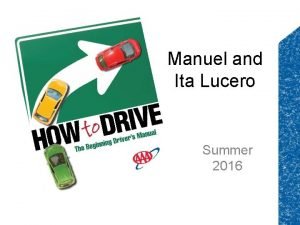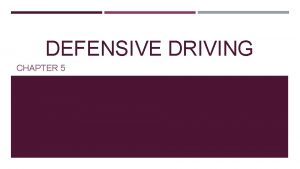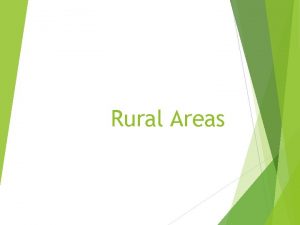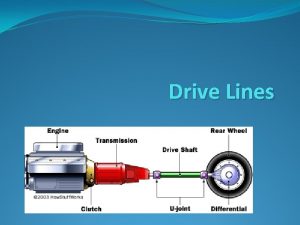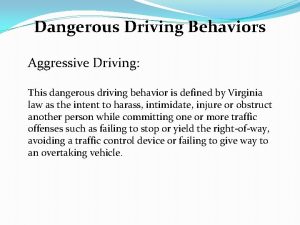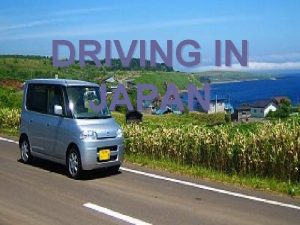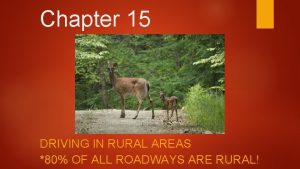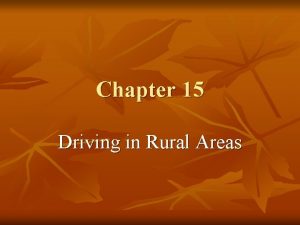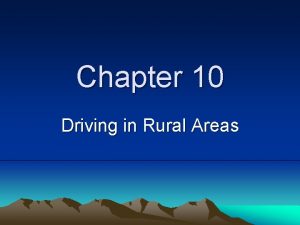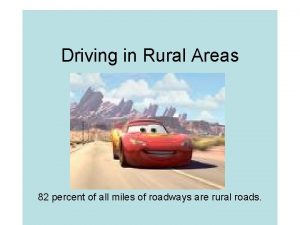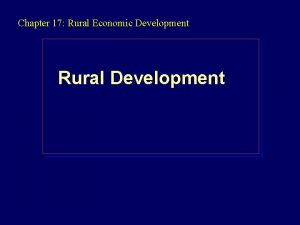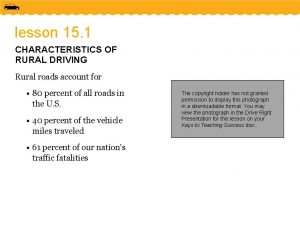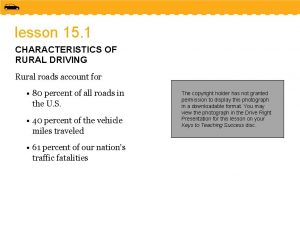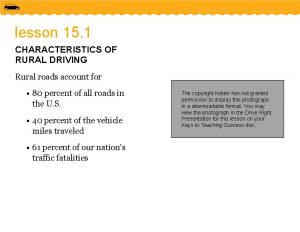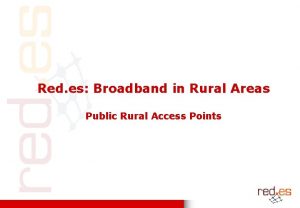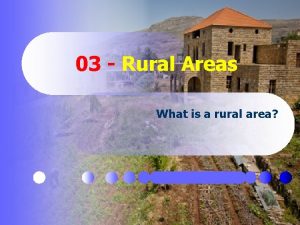Drive Right Chapter 10 Driving in Rural Areas




































- Slides: 36

Drive Right Chapter 10 Driving in Rural Areas Unit 5 Theory Notes from Mr. Miller’s Driver Education Class

10. 1 Characteristics of Rural Traffic • Approximately 82% of all miles of roadways in the US are rural roads. • Collisions in rural areas account for nearly twice as many deaths as urban areas. • Rural roads can be two-lane or multi-lane. • Some rural roads are paved and others are not. • Shoulders can be wide or narrow, paved or gravel. • Road surfaces can be paved or in very poor condition.

10. 1 Characteristics of Rural Traffic • At night, the lack of adequate lighting causes difficulty in seeing. • Pay attention for changing conditions, road condition, curves, etc. • Usually these changes come with little or no warning.

10. 1 Characteristics of Rural Traffic • Speed is critical for safe rural driving. • Speed affects: • Your line of sight. • Your stopping distance. • Your vehicle control. • The amount of damage and injury in the event of a collision. • Many rural roads have a speed limit of 55 mph. Some states allow greater speed limits.

10. 1 Characteristics of Rural Traffic • There is a difference between safe speeds and posted speeds. • Posted speed limits are the maximum speed allowed under ideal conditions. • When conditions are not ideal, safe speeds should be used. Slow down to a safe speed. • Factors that affect safe speed selection include other highway users, inclement weather, hills, curves, intersections and very narrow roads or lanes.

10. 1 Characteristics of Rural Traffic • Traffic Controls • Signs, signals, and markings – direct, regulate, inform, and warn drivers. • They provide advanced warning of: • Hazards that you can’t identify yet. • Major intersections ahead. • Unusual or hazardous conditions (curves, animal crossings, etc. ) • Traffic channeled into reduced space.

10. 1 Characteristics of Rural Traffic • Roadside Hazards • Consider the existing conditions in selecting safe speed. • Shoulders may be uneven with the edge of the roadway, soft, or narrow. • Bridges, guardrails, bushes or trees may be near the road’s edge. • Sign posts may only be a few feet away from the actual roadway. • Steep slopes might run from shoulders. • Entrance to roads may be blocked.

10. 2 Using Basic Skills in Rural Areas • Applying the IPDE Process • You may be forced to make an emergency response on rural roads. • Sudden responses at higher speeds create more problems and risks. • Slow your speed to allow for more time to use the IPDE Process. • Drive at speeds that you know you will be able to brake and steer your vehicle without losing control.

10. 2 Using Basic Skills in Rural Areas • Visual Search Pattern • In your 12 -15 second search range look for clues of hazards that have the potential of closing your front zone. • Strive to maintain a 12 -15 second visual search lead. This is the distance your vehicle will travel in 12 -15 seconds. • Maintaining this visual search lead will help you identify hazards earlier.

10. 2 Using Basic Skills in Rural Areas • Driving on two-lane roads • Curves: • Rural roads typically have many curves. • Collisions happen on curves because speed on the approach is too great. • Look for yellow warning signs. • Warning signs usually have advisory speed signs posted below. • Natural forces work to push you to the outside of the curve.

10. 2 Using Basic Skills in Rural Areas • Driving on two-lane roads • Hills • Unless you have a very steep slope, hills are usually not marked. • Hills restrict your line of sight. • Slow as you approach a hill’s crest. • Look for oncoming traffic and escape to the right if you need an escape path.

10. 2 Using Basic Skills in Rural Areas • Driving on two-lane roads • Intersections • Follow the same procedures learned in earlier chapters for rural intersections. • Early identification of traffic controls will help you predict potential conflicts. • A typical rural intersection is one where a side road crosses a main road.

10. 2 Using Basic Skills in Rural Areas • Driving on two-lane roads • Intersections • The side road will usually have a stop sign. • Tall crops, trees, or shrubs can block or limit the line of sight at rural intersections. • Treat driveways like intersections. • Look for loose gravel, electric poles, reflectors, mailboxes, etc.

10. 2 Using Basic Skills in Rural Areas • Following Traffic • Establish and maintaining at least a 3 second following distance is very important in rural areas. • This following distance provides you with space and time to prevent conflicts.

10. 2 Using Basic Skills in Rural Areas • Following Traffic • You will want to increase your following distance to 4 seconds under these conditions: • Being tailgated • Driving on a steep downhill slope • Following a motorcycle or snowplow • Pulling a loaded trailer • Following a large vehicle • Driving on wet or icy roads

10. 2 Using Basic Skills in Rural Areas • Driving on Multilane Roads • Many have four or more lanes • Posted speed limits are higher • They have intersections instead or ramps • Typically a two lane roadway will cross a larger four way roadway.

10. 2 Using Basic Skills in Rural Areas • Multilane Roadways with Center Lines • Some may only have a yellow line (dashed or solid) separating high speed traffic moving in opposite directions. • Drivers should never cross a solid yellow line or double yellow lines except to make a left turn or clear an obstacle blocking their lane. • Whenever you cross a yellow line, you are responsible to do so safely.

10. 2 Using Basic Skills in Rural Areas • Divided Roadways • Always have lanes of traffic moving in opposite directions separated in some way. • The division may be a simple guardrail or median. • Medians come in a variety of shapes and sizes. • If you cross a median, treat each half as though it were a one-way street. • You will be entering faster traffic.

10. 2 Using Basic Skills in Rural Areas • Lane Choice • Whenever possible, drive in the right lane on a multilane highway, unless signs indicate otherwise. • The left lane is usually for passing or preparing to turn left.

10. 2 Using Basic Skills in Rural Areas • Turning at an Intersection • When leaving a multilane roadway, turn right form the right lane. • When making a left turn, turn from the lane nearest the center line or median strip. • Some intersections may have special turning lanes. • Signal your intention at least 5 seconds ahead of time.

10. 2 Using Basic Skills in Rural Areas • Entering a Multilane Road • To turn right, check left-right-left and enter the nearest right lane. Speed up and move to the left after you have gained speed and clear the intersection. • To turn left, make sure you have a larger gap. Cross the lane on your side of the roadway. Choose the time when no traffic is approaching in the lane just across the center line and turn into the nearest lane.

10. 3 Passing and Being Passed on Rural Roads • Passing on a two lane road carries a higher level of risk than passing on a multilane road. • When you pass on a two lane rural road, you will be in the same lane as oncoming traffic for a short period of time. • Passing another vehicle is really a three stage procedure. • You decide to pass, prepare to pass and execute the maneuver.

10. 3 Passing and Being Passed on Rural Roads • Deciding to pass: • Before you pass a vehicle, assess your situation. • Asked yourself these questions: • Is it worth it to pass? • Is it legal to pass? • Is it safe to pass? Consider passing only if you can answer “yes” to all of these questions.

10. 3 Passing and Being Passed on Rural Roads Take these actions when preparing to pass: • Identify the reason why the front zone is closing. • Check roadway markings. • Check roadway conditions. • Check roadway shoulders. • Check your rearview mirror. • Check quickly over your left shoulder. • Check your rearview mirror. • Check oncoming lane. • Check for driveways.

10. 3 Passing and Being Passed on Rural Roads Executing a Pass on Two-Lane Roads • Keep your 3 second following distance. • Signal when it safe to pass, signal for lane change and check blind spot. • Change lanes smoothly. • Accelerate at least 10 mph faster than vehicle you are going to pass. Don’t speed! • Make final evaluations. • Maintain your speed. • Signal for right lane change. • Return to the right lane.

10. 3 Passing and Being Passed on Rural Roads No Passing on Roads Going Uphill • Passing is not allowed within 700 -1, 000 feet before the top of a hill. No Passing at Intersections • Passing is illegal within 100 feet of an intersection.

10. 3 Passing and Being Passed on Rural Roads Other No-Passing Situations • There are other situations where passing is prohibited or should no be attempted: • Within 100 feet before a Railroad crossing. • On a two-lane bridge or underpass. • On curves, where your line of sign is restricted. • When the vehicle ahead is traveling at speed limit. • When your line of sight is limited fog, snow, or rain. • When several vehicles are ahead of you, pass one at a time. • When you cannot complete a pass before the start of a no passing zone. • Any time oncoming traffic is too close. • When you will be stopping or turning soon.

10. 3 Passing and Being Passed on Rural Roads Passing on Multilane Roads • You need to be cautious when only a centerline separates traffic. • Check all traffic before attempting to pass. • Make sure no one will enter your front zone before you pass. • The vehicle you are passing should be going several mph slower than you are traveling. • All passing should be done in the left lane. • Passing on the right is illegal.

10. 3 Passing and Being Passed on Rural Roads Being Passed • If you are executing a pass, you have the majority of the responsibility to do it safely. • He also have responsibilities when being passed. • You must be aware when another vehicle is passing you. Even if they don’t warn you. • If the passing vehicle is having a difficult time passing you, slow down to help the other driver. • Intentionally speeding up while being passed is illegal. • Only speed up when the driver has decided not to pass and drops back.

10. 4 Rural Situations You Might Encounter • • • In rural situations you may encounter vehicles, animals and situations that you do not encounter on city streets. Slow moving vehicles are unable to travel at highway speeds. Most tractors and other farm equipment qualify. Slow moving vehicles have an orange and red triangle sign on the vehicle. When driving at higher speed, you will rapidly close in on a slow moving vehicle. If you find yourself closing in on a slow moving vehicle, slow down and prepare to pass when it is safe to do so.

10. 4 Rural Situations You Might Encounter • • • Animals can be a problem on rural roads. They can easily become frightened and dart out into your path. Millions of dollars are lost each year by hitting large animals on the roadways. You may see warning signs to alert you potential animal crossings. If you see animals crossing the roadway, slow down and allow them to pass. When small animals appear in the road, be careful and try to avoid hitting them.

10. 4 Rural Situations You Might Encounter • Meeting Oncoming Traffic • Meeting traffic on two way roads may be dangerous. • Head on collisions can cause serious injuries. • Try to move to the right and adjust your lane positioning. • Oncoming drivers may cross into your path for the following reasons: • Blowout, hitting or swerving to avoid a pothole or other debris. • An unexpected loss of traction due to ice, snow, etc. • A distraction or vehicle failure. • An impairment due to alcohol, illness or fatigue

10. 4 Rural Situations You Might Encounter • Meeting Slow Moving Vehicles • When you see a slow moving or stopped vehicle in your left front zone, check to the rear of the vehicle for a passing vehicle. The passing driver may not see you. • Make sure you know where you have an open zone. • If you do not have an open zone, brake enough to create space for yourself or the passing driver.

10. 4 Rural Situations You Might Encounter • Meeting at Night • Be aware at night. • You need to be aware of vehicles in the distance. • Keep your windshield clean. • At night, headlights in the distance can warn you of oncoming traffic. • If you have your high beams on, dim them at least 500 feet from oncoming traffic. • Glance to the right edge of the road to avoid glare from oncoming headlights. • There is often a white line on the edge of the road to assist you with lane positioning.

10. 4 Rural Situations You Might Encounter • Railroad Crossings • Many railroad crossings do not have complete controls (flashing lights and gates). • In rural areas, trains travel at high speeds. • Be alert for railroad crossing warning signs. • Slow and check left and right before crossing. • Never cross a railroad crossing until you know it is absolutely safe to do so. • Remember when a vehicle and a train collide, the train always wins.

10. 5 Special Driving Environments • • Mountains and desserts can challenge your patience, energy and skills. Adhere to the speed limits and warning signs. Mountain roads often zigzag across a mountain with a series of sharp turns called switchbacks. Accelerate steadily when driving uphill to maintain speed because gravity is pulling your vehicle downhill. When you cant see around a curve, slow down. Driving too fast is the leading cause of collisions in the mountains. Large vehicles move more slowly up mountains. Some mountains have pull-out areas where an additional right lane is provided for slower moving vehicles.
 Drive right chapter 10 answer key
Drive right chapter 10 answer key Chapter 15 driving in rural areas
Chapter 15 driving in rural areas Rural areas have of development drivers ed
Rural areas have of development drivers ed Chapter 10 driving in rural areas worksheet answers
Chapter 10 driving in rural areas worksheet answers Right product right place right time right price
Right product right place right time right price Family time
Family time Googlehttps://drive.google.com/drive/my-drive
Googlehttps://drive.google.com/drive/my-drive Slidetodoc
Slidetodoc Rit google drive
Rit google drive The right man on the right place at the right time
The right man on the right place at the right time Difference between urban and rural
Difference between urban and rural Usda rural areas in massachusetts
Usda rural areas in massachusetts How do you steer straight forward and back- ward?
How do you steer straight forward and back- ward? Chapter 1 you are the driver
Chapter 1 you are the driver Drive right chapter 8
Drive right chapter 8 Drive right chapter 1
Drive right chapter 1 Chapter 4 performing basic maneuvers worksheet answers
Chapter 4 performing basic maneuvers worksheet answers Chapter 9 driving in urban traffic
Chapter 9 driving in urban traffic Chapter 8 sharing the roadway answers
Chapter 8 sharing the roadway answers Drive right chapter 5
Drive right chapter 5 Drive right chapter 11
Drive right chapter 11 Drive right chapter 1
Drive right chapter 1 Cross belt drive
Cross belt drive 1https://drive.google.com/drive/u/1
1https://drive.google.com/drive/u/1 Https drive google com
Https drive google com Difference between chain drive and belt drive
Difference between chain drive and belt drive Https drive google com drive u 0 recent
Https drive google com drive u 0 recent Chapter 9 agricultural transformation and rural development
Chapter 9 agricultural transformation and rural development Chapter 9 agricultural transformation and rural development
Chapter 9 agricultural transformation and rural development Left right go turn around go go go
Left right go turn around go go go Put your right foot in
Put your right foot in Left left right right go go go
Left left right right go go go Chapter 1 driving and mobility
Chapter 1 driving and mobility Chapter 1 managing risk when driving
Chapter 1 managing risk when driving As you enter the deceleration lane
As you enter the deceleration lane Inhibitions drivers ed
Inhibitions drivers ed Chapter 5 defensive driving quiz answers
Chapter 5 defensive driving quiz answers
